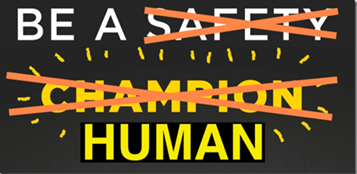 There are so many silences in safety I’m sure we could keep this series going for months (https://safetyrisk.net/category/safety-culture-silences/ ) but perhaps just a few more and we might call it ‘quits’.
There are so many silences in safety I’m sure we could keep this series going for months (https://safetyrisk.net/category/safety-culture-silences/ ) but perhaps just a few more and we might call it ‘quits’.
But you have to ask yourself, why is Safety so noisy on so many petty things and so silent on such critical things? Especially when it comes to culture.
For example, there is no discussion at all in the AIHS BoK Chapter on Ethics on helping, care, personhood or empathy. All critical for any approach to engagement in tackling risk.
Even more so, when considering the follow up to any event. Similarly, there is no skill development at all in any WHS curriculum on empathy, developing understanding, helping, listening or care. Just such an astounding indictment of an industry that loves to use the word ‘professional’.
Research (https://psycnet.apa.org/record/1978-31507-001 ) shows that empathy is crucial for moral development, maintaining relationships, inhibiting aggression, fostering well-being, belonging to groups and leadership decision making.
However, we need to take a close look at defining empathy and this is also coloured by one’s worldview. You can’t just go to a dictionary definition if one wants to understand sympathy, empathy, compassion, suffering, passion and harm (https://www.academia.edu/38051407/Empathy_Sympathy_and_Compassion_2020 ). If you read Breyer you would think that empathy is an intellectual, brain-centric exercise.
Even though Breyer attempts a Phenomenonological understanding, his analysis is hopelessly disconnected from embodiment, interaffectivity and intercorporeality (https://www.academia.edu/30974462/Intercorporeality_and_Interaffectivity ).
At its very foundation empathy is about embodied resonance with an ‘other’.
Empathy is about much more than understanding, taking another’s perspective, ‘feeling like’ and ‘togetherness’. Speaking about empathy is such ways is similar to the mythology that cognitive dissonance is about belief incongruence and discomfort in thought.
There can be no empathy without Socialitie (https://safetyrisk.net/culture-silences-in-safety-socialitie/ ), another profound silence in safety.
And you’ll get no empathy from a deontological behaviourist ethic. The ethic that Safety loves.
You also won’t get any empathy from ‘resilience engineering’ either (https://safetyrisk.net/ecological-resiliencing/ ). Such is the focus of so called ‘safety differently’ on systems, that cares about the resilience of systems, not persons. Similarly, ‘human factors’ where humans are just ‘factors’ in systems. When your method is about the ‘functional resonance’ of systems, you might as well do a Bow-Tie. There is no ‘difference’ in worldview (https://safetyrisk.net/the-safety-and-new-view-debate/ ). In such a worldview there remains no discussion on an ethic of risk.
When your practice (methods) results in brutalism, you know the methodology-ethic behind it will be silent on personhood, care, helping and empathy.
Empathy is reliant on self-understanding, having ‘resonance’ with one’s ‘self’. An ethic of selfhood is reliant on an ethic of personhood, they are the flip side of the same coin. Empathy is not just about ‘understanding’ the emotions of the other, it is an intuitive ‘knowing’ and ‘being’ in resonance with an ‘other’.
Unless this ‘resonance’ is emphasized in worldview, it is ‘a piece of cake’ to brutalise others in the name of good.
When the focus of safety is on hazards, objects and compliance, demonizing others is easy, especially when the ideology is zero.
In safety, persons are not persons but numbers, objects to count that get in the way of zero. When safety is defined as injury rates, people will be harmed (socially and psychologically).
Just listen to the language of Safety when He tells you what safety is, it’s not about helping people but controlling hazards. Listen to the talk of ‘safety differently’, it’s always the focus on systems. Such is the cultural silence of safety on language and learning (https://safetyrisk.net/culture-silences-in-safety-language/ ). So much of the discourse about safety is binary and dis-embodied. So much is about correct data and information, not about embodied learning.
The beginning in understanding empathy is moving away from brain-centrism to a holistic understanding of persons. Such is the foundation for an ethic of risk.
Of course, if an ethic of risk and an understanding of culture includes empathy, zero has to go. Goodness me, just imagine, moving away from zero so that safety improves (https://safetyrisk.net/moving-away-from-zero-so-that-safety-improves/ ). When your ideology is a number, there can be no empathy.



Doug Fatches says
Our new safety people walking out of training a organisation with a qualifications of some description, believing now that they are a “Safety Professional”, You might ask where do they get the good oil from?
Without the tones of George Robotham, the philosophies of Dr Rob, We often get pushed into “best practice OH&S” from our corporate salary givers, you will receive a lot of bumps, before you can fill in the gaps. To truly lead in safety, you first need to humanise the people being impacted, have a relationships with the employees so that they might trust you, become trust worthy.
Remember nobody comes to work to hurt themselves or their work mates, we are all looking for our basic needs, To feel Safe, Warm & Full belly, to achieve that at work, takes practice when you have been only taught the rules.